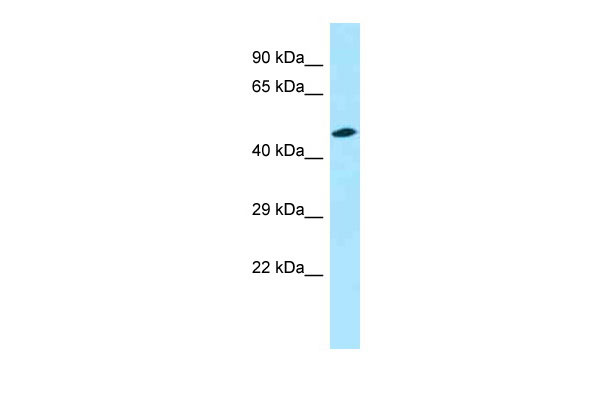Opn3 antibody - C-terminal region
Rabbit Polyclonal Antibody
- SPECIFICATION
- CITATIONS
- PROTOCOLS
- BACKGROUND

Application
| WB |
|---|---|
| Primary Accession | Q9WUK7 |
| Other Accession | NM_010098, NP_034228 |
| Reactivity | Human, Mouse, Rat, Rabbit, Horse, Guinea Pig, Dog |
| Predicted | Human, Mouse, Rat, Rabbit, Chicken, Dog |
| Host | Rabbit |
| Clonality | Polyclonal |
| Calculated MW | 45kDa |
| Gene ID | 13603 |
|---|---|
| Alias Symbol | ERO, Ecpn, MGC124138, panopsin |
| Other Names | Opsin-3, Encephalopsin, Panopsin, Opn3, Ecpn |
| Format | Liquid. Purified antibody supplied in 1x PBS buffer with 0.09% (w/v) sodium azide and 2% sucrose. |
| Reconstitution & Storage | Add 50 ul of distilled water. Final anti-Opn3 antibody concentration is 1 mg/ml in PBS buffer with 2% sucrose. For longer periods of storage, store at 20°C. Avoid repeat freeze-thaw cycles. |
| Precautions | Opn3 antibody - C-terminal region is for research use only and not for use in diagnostic or therapeutic procedures. |
| Name | Opn3 |
|---|---|
| Synonyms | Ecpn |
| Function | G-protein coupled receptor which selectively activates G proteins via ultraviolet A (UVA) light-mediated activation in the skin (PubMed:30284927). Binds both 11-cis retinal and all-trans retinal (By similarity). Regulates melanogenesis in melanocytes via inhibition of alpha-MSH-induced MC1R-mediated cAMP signaling, modulation of calcium flux, regulation of CAMK2 phosphorylation, and subsequently phosphorylation of CREB, p38, ERK and MITF in response to blue light (By similarity). Plays a role in melanocyte survival through regulation of intracellular calcium levels and subsequent BCL2/RAF1 signaling (By similarity). Additionally regulates apoptosis via cytochrome c release and subsequent activation of the caspase cascade (By similarity). Required for TYR and DCT blue light-induced complex formation in melanocytes (By similarity). Involved in keratinocyte differentiation in response to blue-light (By similarity). Required for the UVA- mediated induction of calcium and mitogen-activated protein kinase signaling resulting in the expression of MMP1, MMP2, MMP3, MMP9 and TIMP1 in dermal fibroblasts (By similarity). Plays a role in light- mediated glucose uptake, mitochondrial respiration and fatty acid metabolism in brown adipocyte tissues (PubMed:32040503). May be involved in photorelaxation of airway smooth muscle cells, via blue- light dependent GPCR signaling pathways (PubMed:30284927). |
| Cellular Location | Cell membrane {ECO:0000250|UniProtKB:Q9H1Y3}; Multi-pass membrane protein. Cytoplasm {ECO:0000250|UniProtKB:Q9H1Y3} |
| Tissue Location | Expressed in the eye (at protein level) (PubMed:30284927). Expressed in tracheal airway smooth muscle (PubMed:30284927). Expressed in brown adipocyte tissue; expression becomes more abundant during differentiation (PubMed:32040503) Strongly expressed in brain (PubMed:10234000). Highly expressed in the preoptic area and paraventricular nucleus of the hypothalamus (PubMed:10234000). Shows highly patterned expression in other regions of the brain, being enriched in selected regions of the cerebral cortex, cerebellar Purkinje cells, a subset of striatal neurons, selected thalamic nuclei, and a subset of interneurons in the ventral horn of the spinal cord (PubMed:10234000) |

Thousands of laboratories across the world have published research that depended on the performance of antibodies from Abcepta to advance their research. Check out links to articles that cite our products in major peer-reviewed journals, organized by research category.
info@abcepta.com, and receive a free "I Love Antibodies" mug.
Provided below are standard protocols that you may find useful for product applications.
References
Blackshaw S.,et al.J. Neurosci. 19:3681-3690(1999).
Kasper G.,et al.Gene 295:27-32(2002).
Carninci P.,et al.Science 309:1559-1563(2005).
If you have used an Abcepta product and would like to share how it has performed, please click on the "Submit Review" button and provide the requested information. Our staff will examine and post your review and contact you if needed.
If you have any additional inquiries please email technical services at tech@abcepta.com.













 Foundational characteristics of cancer include proliferation, angiogenesis, migration, evasion of apoptosis, and cellular immortality. Find key markers for these cellular processes and antibodies to detect them.
Foundational characteristics of cancer include proliferation, angiogenesis, migration, evasion of apoptosis, and cellular immortality. Find key markers for these cellular processes and antibodies to detect them. The SUMOplot™ Analysis Program predicts and scores sumoylation sites in your protein. SUMOylation is a post-translational modification involved in various cellular processes, such as nuclear-cytosolic transport, transcriptional regulation, apoptosis, protein stability, response to stress, and progression through the cell cycle.
The SUMOplot™ Analysis Program predicts and scores sumoylation sites in your protein. SUMOylation is a post-translational modification involved in various cellular processes, such as nuclear-cytosolic transport, transcriptional regulation, apoptosis, protein stability, response to stress, and progression through the cell cycle. The Autophagy Receptor Motif Plotter predicts and scores autophagy receptor binding sites in your protein. Identifying proteins connected to this pathway is critical to understanding the role of autophagy in physiological as well as pathological processes such as development, differentiation, neurodegenerative diseases, stress, infection, and cancer.
The Autophagy Receptor Motif Plotter predicts and scores autophagy receptor binding sites in your protein. Identifying proteins connected to this pathway is critical to understanding the role of autophagy in physiological as well as pathological processes such as development, differentiation, neurodegenerative diseases, stress, infection, and cancer.


